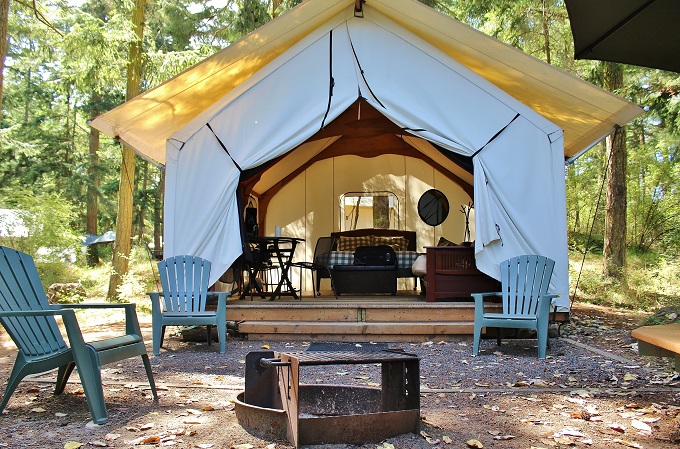
How to indulge guests’ lust for luxe without spending a fortune
Glamping is the accom phenomenon taking the rough out of roughing it.
It allows a re-connection with nature without any of the headaches normally associated with sleeping under the stars.
There’s no frantic packing of towels and bedding, tin mugs and dented frying pans, gazebos and barbeques. There’s no climbing into a grit-laden sleeping bag.
But there is the romance of a night under canvas listening to the sounds of the bush or the ocean – still audible over the gurgle of your Nespresso milk frother.
More ‘Out of Africa’ than ‘Carry on Camping’, glamping is unashamedly stylish and comfortable.
So what do would-be glamping operators need to know?
Glamping requires sturdy, permanent tent-like structures, equipped with luxuries such as comfy beds, throws, aircon and ensuites. The most luxurious command price tags equivalent to a top hotel room – but can be put together for considerably less.
According to the blog www.fdomes.com: “It might look like the owners invested their seven-figure nest eggs to get those luxury camping sites rolling, but no.
“Hundreds of glamping sites already out there, and still more popping up, are a living proof that the business pays off and is here to stay.”
The first step is to define your guests and their expectations are. From families and couples to business groups, diverse needs must be considered; honeymooners and VIPs may not enjoy sharing their glamping experience with families, whereas activity tourists might be more amenable.
When it comes to facilities, will you provide a laundry room, a games room, spa, pool? Will you have cooking areas and shared bathrooms or include those facilities within each tent?
Location
A plot of land away from traffic but with good access is a perfect starting point. It must be well-drained, offer wind protection and allow for parking. Any luxe camping environment will need power, waste disposal facilities, fire safety measures and sanitary facilities.
Regulation
Each state and council within it have their own rules governing camping, but wherever your proposed site, it’s imperative to check that zoning is appropriate prior to applying for approval.
Wherever your setup, you will need to acquire a development permit for any change of use when it comes to your glamping site.
Once approval is given, it will need renewing at regular intervals – those timings again varying from state to state.
Pandering to glamping
A business which creates tourism and employment with minimal environmental impact is generally welcomed with open arms and may be eligible for a supporting development grant. Diversification which supports a primary business, like glamping on farmland, is particularly sought after.
Choosing your structure
Glamping covers everything from yurts and safari tents to converted caravans, pods, barns, cabins and domes.
If you go the tent route, premium quality canvas with up to 20 years’ longevity and sturdy steel or wooden frames are a must.
The canvas needs to be tough, waterproof and fire retardant (essential if you are going to fit a wood burner). Top quality will result in a better return on your investment as the materials will last longer.
Standardised pre-fabricated glamping kits allow you to assemble the structure yourself and while they’re less customisable, can save a lot of money. Many include wood-burners and insulation, making them year-round solutions.
Making your tents unique is vital and providing cosy and luxury touches is imperative if you’re looking to charge decent rates.
Money and maintenance
At the beginning of each season, you’ll need to hose down tents and rub any marks clean with a cloth. No chemicals are required so this is perfect for environmentally sensitive areas.
The cost of a quality 6m x 7m safari tent is around $7000.
Allowing around $3,500 for the base and internal decoration, you could recoup the cost of that tent in a few months by charging an average glamping rate of around $290 per night.
Across Australia, pricing varies from around $100 to $800 per night (dependent on location, amenities and season).
Remember, it’s OK to start small. Two or three yurts may not break the bank but enable you to learn what works before you decide to decide to invest wholesale in your glamping empire.

AccomNews is not affiliated with any government agency, body or political party. We are an independently owned, family-operated magazine.





